Originally published on The Bogman’s Cannon
Dear Readers…
Dear loyal readers of my sporadic blog. If you’d like to stay in touch, please please follow me over at the new address for the blog: http://www.abelfastblog.com
Thanks!
Jonathan

Top 10 Ways to Live like the Captain
 Lately my attention has been caught by billboards around Belfast City advertising Captain Morgan’s gin (I think it is a gin). For those unfamiliar, the billoard shows an image of a swashbuckling figure bearing a sword and is accompanied by a short text that urges readers to:
Lately my attention has been caught by billboards around Belfast City advertising Captain Morgan’s gin (I think it is a gin). For those unfamiliar, the billoard shows an image of a swashbuckling figure bearing a sword and is accompanied by a short text that urges readers to:
‘Live like the captain’.
This exhortation has left me perplexed. I am left with many unanswered questions, such as ‘Why should I live like the captain?’; ‘Who is the captain and how, indeed, does he live?’; and not least: ‘If I am to live like the captain, what sort of life am I being encouraged to emulate? Where does one begin?’
Admittedly, the captain, assuming that the likeness is faithful, looks in the full bloom of health, of total control of his destiny and, it is fair to say, rakishly handsome. I myself sport long hair and a beard and surely it would not be sucha a great step to don a captain’s hat, billowing trousers, leather boots and … wait. I’m getting ahead of myself. Before making any rash decisions on following in the captain’s footsteps, I will first try to answer some of those troubling questions.
I start with a Google search for the man himself, Captain Morgan. Here are my notes:
‘Captain Morgan is a brand of rum [not a gin] produced by alcohol conglomerate Diageo [ah, but of course…]. It is named after the 17th-century Welsh privateer [privateer?] of the Caribbean, Sir Henry Morgan [I didn’t know Welsh people were made sirs] who died on 26 August 1688.
So, he is a real person. The date of death is very specific. I have some slight concerns. Also, it doesn’t say how he died. I decide to press on because we’re only being ask to live like the captain.
Also:
‘Sir Henry Morgan (Harri Morgan in Welsh; ca. 1635 – 25 August 1688) [a date discrepancy already] was a Welsh privateer [privateer?], pirate and admiral of the English Royal Navy.
How can you be a pirate and an admiral of the Royal Navy? Is this a naïve question?
I also make a series of notes on his life and whittle them down to a shortlist of ten pointers or guidelines. In my research I pay particular attention to details of his life which one could attempt to emulate in modern times. In my opinion, Diageo would be well advised to append this list to their plea to the citizens of Belfast to ‘Live like the Captain’. I believe it serves not only as a useful series of pointers to those struggling to decide how to embark on such an endeavour, but it also makes clear the pitfalls and dangers of the path should one choose to follow it. Several of the points below may be of interest to Diageo’s legal department with regard to the activities they are perhaps unwittingly condoning by proxy:
Top ten ways to live like the captain:
- Leave school early
- Command a ship
- Be a privateer [what’s a privateer?]
- Seize some islands, plunder the coast of Mexico then ravage the coast of Cuba.
- Ruthlessly destroy Spanish forts even after they have been surrendered.
- Torture residents
- Have an Englishman hanged
- Organise an ambush in a narrow passage [the City Gate Project has made this difficult]
- Invite French people to dinner and then imprison them .
- Dress in “red silk and […] fancy gold and jewels” in order to appear to be “extremely successful” [I reckon I’ll start here].
T-Mo Rex

A quick free job for a good cause based on a concept by my good friend in Australia.
I went and set the Thames on fire
I’ve had pretty much one e-mail address since I was first exposed to e-mail way back in 1996. It’s both a blessing (everything’s in there) and a curse (6,000 unread messages and counting). Occasionally, e-mail searches throw up some interesting results – like this track listing and lyric samples for a CD compilation I think I did actually make in 2009 for a good friend:
- The Strokes – You Only Live Once
- Radiohead – The Pyramid Song
- The Jam – Tales From The Riverbank
- Pink Floyd – Wot’s… Uh The Deal
- Morrissey – To Me You Are A Work Of Art
- Pink Floyd – Nobody Home
- The Strokes – Ask Me Anything
- David Bowie – Kooks
- The Walker Brothers – Archangel
- David Bowie – The Man Who Sold The World
- Van Morrison – It’s All Over Now Baby Blue
- David Bowie – Five Years
- Blur – Out Of Time
- Radiohead – Faust Arp
- The Smiths – The Boy With The Thorn In His Side
- Tom Waits – Anywhere I Lay My Head
some people think they’re always right, others are quiet and uptight – we all went to heaven in a little row boat, there was nothing to fear and nothing to doubt – true it’s a dream, mixed with nostalgia, but it’s a dream that i’ll always run to – let me in from the cold, turn my lead into gold – i see the world, it makes me puke, but then I look at you… – i’ve got thirteen channels of shit on the tv to choose from – hostile indians, we named a summer camp for you – don’t pick fights with the bullies or the cads ‘cos i’m not much cop at punching other people’s dads – archangel rising on the moon, just to save me from this tomb – you’re face to face with the man who sold the world – crying like a fire in the sun – smiling and waving and looking so fine, don’t think you knew you were in this song – watch the world spinning gently out of time – watch me fall like dominoes in pretty patterns – behind the hatred there lies a murderous desire for love
For some reason the Tom Waits song doesn’t feature in the lyric sample area (which reading now I must have thought encompassed the best lines from each song). So here goes:
I went and set the Thames on fire, now I must come back down
The Linen Hall Library
The Linenhall Library was one of the first places I discovered in Belfast. However, I’ve been reluctant to write about it until now, for fear of not doing it justice, because it really is a wonderful treasure, and it’s right in the heart of Belfast City.
The library was originally located in the White Linen Hall which occupied the site of the present day City Hall, hence the name. Also, its present location, on Donegall Square, was itself the site of a linen warehouse. The library has had its ups and downs over the years, and was almost shut down definitively in 1980, just over 200 years after its establishment as the Belfast Society for the Promoting of Knowledge. However, it seems to be thriving today, and modern concessions such as wifi, a café and an extension have not marred the unique character of the place.
Strolling in from Donegall Square, you pass under the petrified drapes of the entrance, and across the tesellated floor spelling out the institution’s name. Then, a staircase sweeps you up into the heart of the place. The members area, with its comfy seats and green-glass gooseneck reading lamps, beckons from the corner as you ascend a second staircase, leaving the bustle of the streets below even further behind. Here, the sense of stepping back in time is even greater – from the windows on this floor you cannot see the Boots, Mace, Halifax, First Trust, Marks & Spencers, etc. that brand the banks of the city’s thoroughfares with cladding and logos. Seated in your wooden chair, on the slightly leaning floor, all you see are the upper stories: the copper cupolas of City Hall, the stopped clock of the Scottish Provident building and a canopy of trees. Nothing seems to have changed over the centuries.
The Linen Hall is a place to research, to study, to relax, to have a coffee and, judging from some of the visitors, to have a snooze. It’s primarily a place to think, and there’s nowhere quite like it.
The Linen Hall Library is open Monday to Friday: 9.30am – 5.30pm and Saturday: 9.30am – 4.00pm.
Find out more on http://www.linenhall.com
Thanks to staff for allowing me to take photos.

Divis and the Black Mountain (Das Boot, agoraphobia and geocaching)
Last week I took advantage of a rare sunny day to do some hiking in the hills around Belfast. I put on my hiking boots and backpack and drove up to Divis and the Black Mountain carpark (if you think the mountain looks daunting from central Belfast, you should know that the carpark is already quite a way up the mountain).
The area, having been in private hands for decades, is now cared for by The National Trust, and they have produced a simple map with various walking trails marked out. On the site, there are two sealed-off areas with radio and television masts. I guess that it is because these areas need occasional servicing, or the BBC’s vicious-looking guard dogs need occasional feeding, that the route that ascends to the summit of Divis (1562ft / 476m) is a proper road, with yield signs and speed limits, etc. (no public access). As a result, you may feel that you’re not really getting out into the wild – however, it does means that the summit is accessible (I passed a family with a son in a wheelchair). Also, there are alternative, more difficult, paths (especially if you get lost…) for those who want them. And lastly, the views from the top are so stunning that it really doesn’t matter!
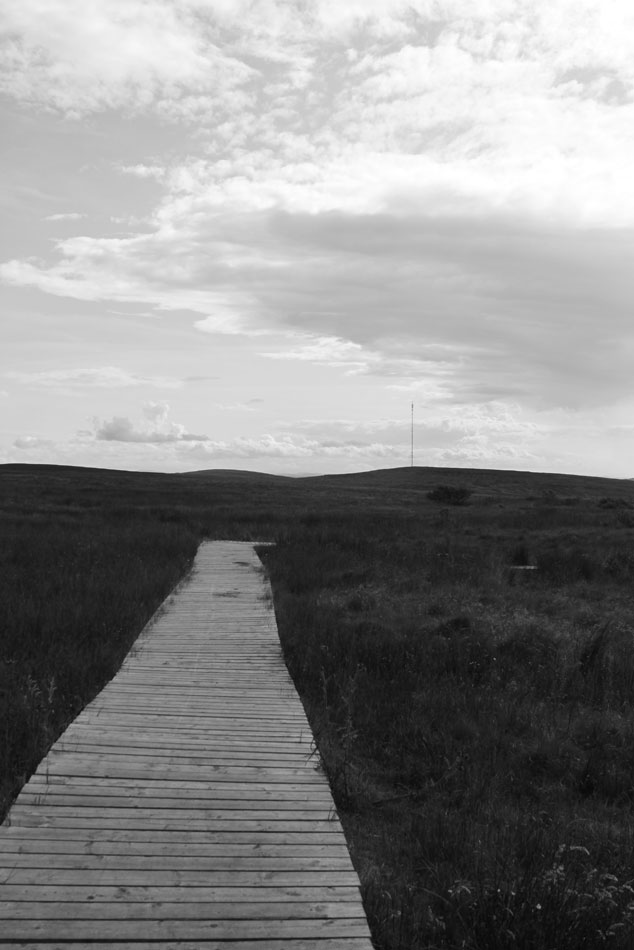
I started with the Black Mountain. Much of this path is a wooden boardwalk which takes you across squelching bogland. The summit is marked by a stone pillar, and gives a taste of the views from the top of Divis. The view from there is even better, not only can you gaze right down the middle of Belfast Lough to Scotland beyond, but you can also see Lough Neagh from the other side. It’s pretty much a 360 degree view over Northern Ireland and, on a clear day, is just breathtaking.
After following the routes to both summits, I tried the so-called ‘Tipperary trail’ (no idea how it got this name, my guess being that it’s because it’s a long way – or maybe Germans named it? ). At a certain point down this route you need to take a left turn – I missed it, retraced my steps, and then realised that the ‘path’, which, confusingly, is given the same priority on the map as the sealed road, was actually a series of thick posts, each spaced about 20 metres apart, stretching off over bogland and the sources of several rivers. This was fine, up until the point where the posts ended – seemingly in the middle of nowhere. At this stage I followed, what I later learned, was an old famine wall leading up the side of Divis – and this is where things got interesting again.
I came across a small patch of open ground with some industrial debris laying around, and next to this, buried in the heather, a large tupperware wrapped in camouflage. I opened it (my wife, who is from ‘the North’, later warned me that one probably shouldn’t open concealed, camouflaged boxes in Belfast) to find, what I soon learned, was a ‘Geocache’. Inside I found several plastic toys, leaflets about the National Trust and a log book. If you are not familiar with geocaching, think of a global, orienteering treasure hunt, or a party that’s been going on all around you that you never noticed, or a hidden world of hiding places, GPS devices and nerds (for me, the term is not pejorative) operating below ‘muggle’ radar. Find out more on www.geocaching.com. Oh yes, and from this site I discovered that my ‘industrial debris’ was in fact the remains of a military aircraft crash from some time in the 40s.
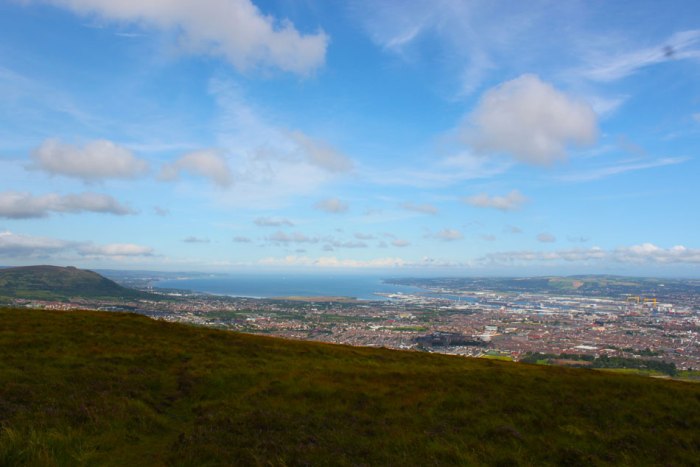
The rest of my walk is inconsequential – basically aiming for the carpark once it came into view, and avoiding the bulls. As an aside – just before setting out, I had been examining the area using the Google maps satellite view. This is something I think need to stop doing as it seems to be coaxing to life some trace of agoraphobia I have buried within me.
Is it just me? Or do spaces like this and this give you the creeps?
Next step – the Mournes.
Sinclair Seamen’s Church
The Rough Guide to Ireland‘s section on Belfast has an entry for a curious church in the docklands area, situated more or less on the quay opposite the Odyssey arena. The entry invites readers to head down Dongell Quay, if the sea air is “twitching your nose”, towards the ferry terminal buildings and an unusual little church called the ‘Sinclair Seaman’s Church’. Last Wednesday, in the pouring rain, I decided to make the trip.
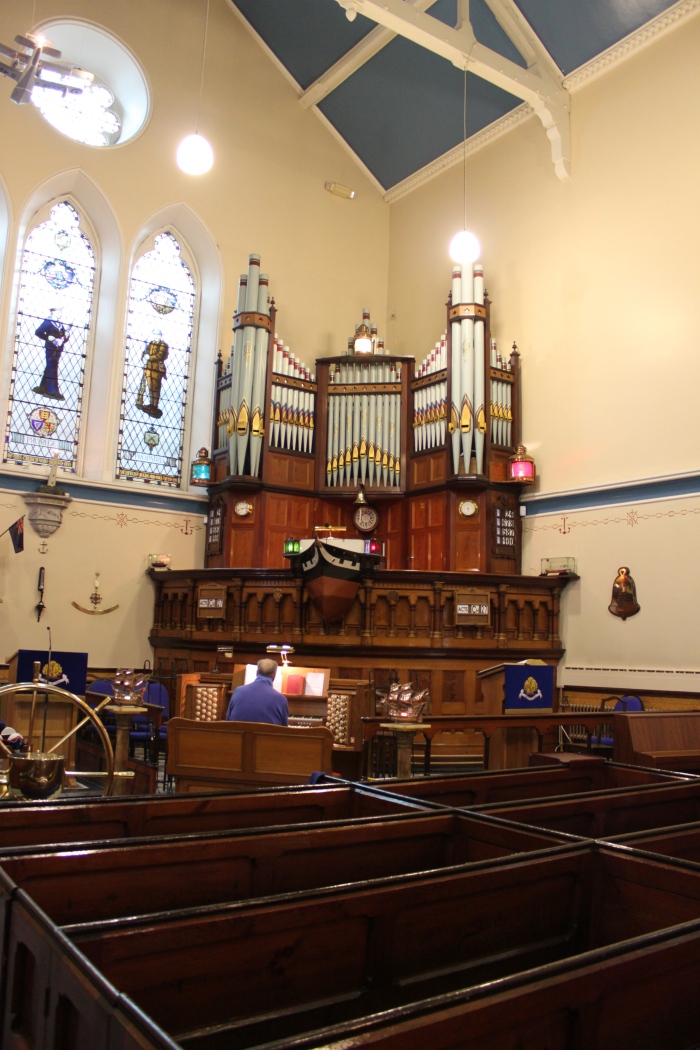
Dating from 1857, the church is fairly unassuming from the outside – you have to enter (visits Wednesdays, 14:00 – 17:00) to see its real treasures, all on a maritime theme. The day I visited, I was met by the Reverend, who was expecting the organist, and he kindly gave me a tour of the building. A binnacle, a ship’s wheel, a bell from the HMS Hood, the mast of a boat once used to ferry Guinness up and down Dublin’s Liffey, and various other nautical equipment fill this maritime church – even the collection plates are in the shape of lifeboats. Everything is beautifully maintained.
Perhaps the most unusual feature is the pulpit. It is designed to look like the prow of a ship. The image of Orson Welles climbing up his rope ladder into the prow shaped pulpit in John Huston’s film version of Moby Dick immediately sprang to mind, because this is my only reference point for a pulpit of this type (I was also reminded of the wonderful Schiffergesellschaft in Lübeck, in former East Germany). Apparently I wasn’t the only one to be reminded of Orson’s sermon – the Reverend told me they had recently hosted a screening Moby Dick in the church.
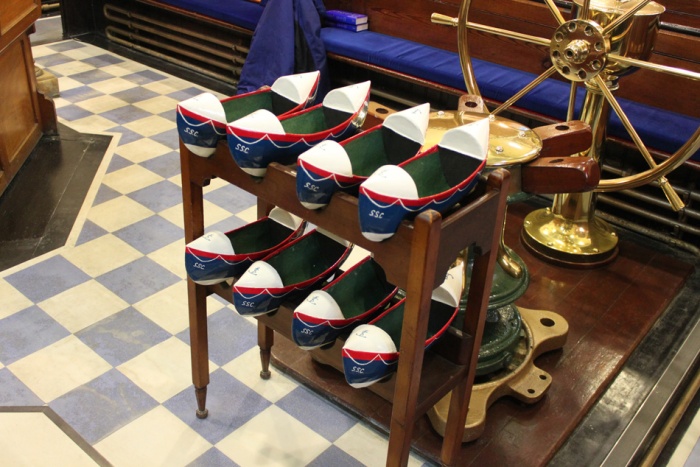
You can find out more the Sinclair Seamen’s Church on the Virtual Visit Northern Ireland site, but of course the best way to experience it is in person. And so, the next time the wind is howling and the rain is horizontal, why not venture down this way, I’m sure you’ll enjoy it. I will be this way again – I’ve heard great things about the Rotterdam Bar in nearby Sailortown although I fear it may already be closed for good.
A Belfast blog
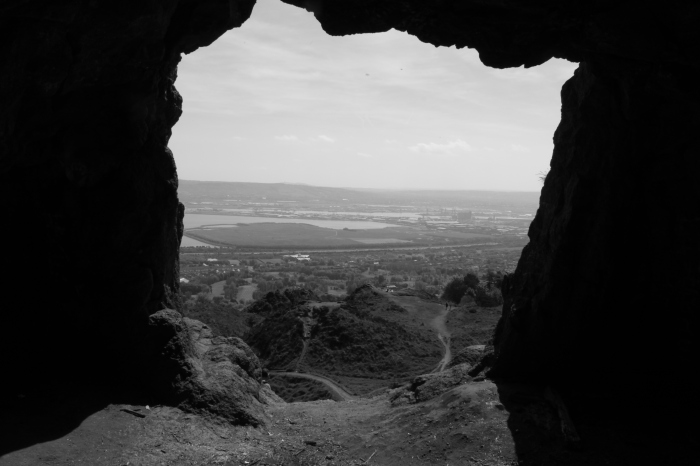
Belfast is my adopted city. It’s only been a few months, so I’m still in the exploratory phase, i.e. wandering around, talking to people I meet, making an effort to acclimatise.
This blog might have been called ‘A Dub in Belfast’ or ‘An Idiot in Belfast’ – in reference to where I come from (Dublin) and how daunting Belfast can seem if you’re not from here, or from Northern Ireland for that matter (the idiot part).
I’ll be posting about my discoveries. I promise to keep an open mind. Help me out if you can.